Spatio-Temporal Patterns of Warm-Season Ground Surface Temperature—Surface Air Temperature Difference over China Mainland
Abstract
1. Introduction
2. Data and Methods
2.1. Data
2.2. Methods
3. Results
3.1. Spatial Distribution
3.2. Temporal Variations
3.3. Possible Factors Affecting GST–SAT
4. Discussion
4.1. GST–SAT
4.2. Influencing Factors of GST–SAT
5. Conclusions
Supplementary Materials
Author Contributions
Funding
Data Availability Statement
Acknowledgments
Conflicts of Interest
References
- Dickinson, R.E. Land Surface Processes and Climate—Surface Albedos and Energy Balance. Adv. Geophys. 1983, 25, 305–353. [Google Scholar]
- Bonan, G.B. Forests and climate change: Forcings, feedbacks, and the climate benefits of forests. Science 2008, 320, 1444–1449. [Google Scholar] [CrossRef] [PubMed]
- Matsumura, S.; Yamazaki, K.; Tokioka, T. Summertime land-atmosphere interactions in response to anomalous springtime snow cover in northern Eurasia. J. Geophys. Res. Atmos. 2010, 115, D20107. [Google Scholar] [CrossRef]
- Xue, Y.K.; Juang, H.M.H.; Li, W.P.; Prince, S.; DeFries, R.; Jiao, Y.; Vasic, R. Role of land surface processes in monsoon development: East Asia and West Africa. J. Geophys. Res. Atmos. 2004, 109, D03105. [Google Scholar] [CrossRef]
- Siemann, A.L.; Chaney, N.; Wood, E.F. Development and Validation of a Long-Term, Global, Terrestrial Sensible Heat Flux Dataset. J. Clim. 2018, 31, 6073–6095. [Google Scholar] [CrossRef]
- André, J.C.; Goutorbe, J.P.; Perrier, A. HAPEX—MOBLIHY: A Hydrologic Atmospheric Experiment for the Study of Water Budget and Evaporation Flux at the Climatic Scale. Bull. Am. Meteorol. Soc. 1986, 67, 138–144. [Google Scholar] [CrossRef]
- Sellers, P.; Hall, F.; Ranson, K.J.; Margolis, H.; Kelly, B.; Baldocchi, D.; den Hartog, G.; Cihlar, J.; Ryan, M.G.; Goodison, B.; et al. The Boreal Ecosystem–Atmosphere Study (BOREAS): An Overview and Early Results from the 1994 Field Year. Bull. Am. Meteorol. Soc. 1995, 76, 1549–1577. [Google Scholar] [CrossRef]
- Tao, S.Y.; Chen, L.S.; Xu, X.D. Theoretical Research Progress of the Second Atmospheric Science Experiment on the Qinghai-Tibet Plateau; China Meteorological Press: Beijing, China, 1999. (In Chinese) [Google Scholar]
- Zhang, Q.; Huang, R.H.; Wang, S.; Wei, G.A.; Cao, X.Y.; Hou, X.H. NWC-ALIEX and its research advances. Adv. Earth Sci. 2005, 20, 357–362. (In Chinese) [Google Scholar]
- Koster, R.D.; Suarez, M.J. Soil moisture memory in climate models. J. Hydrometeorol. 2001, 2, 558–570. [Google Scholar] [CrossRef]
- Hu, Q.; Feng, S. A Role of the Soil Enthalpy in Land Memory. J. Clim. 2004, 17, 3633–3643. [Google Scholar] [CrossRef]
- Hu, Q.; Feng, S. Why Has the Land Memory Changed? J. Clim. 2004, 17, 3236–3243. [Google Scholar] [CrossRef]
- Yang, K.; Zhang, J.Y. Spatiotemporal characteristics of soil temperature memory in China from observation. Theor. Appl. Climatol. 2015, 126, 739–749. [Google Scholar] [CrossRef]
- Xue, Y.K.; Yao, T.D.; Boone, A.A.; Diallo, I.; Liu, Y.; Zeng, X.; Lau, W.K.M.; Sugimoto, S.; Tang, Q.; Pan, X.; et al. Impact of Initialized Land Surface Temperature and Snowpack on Subseasonal to Seasonal Prediction Project, Phase I (LS4P-I): Organization and experimental design. Geosci. Model Dev. 2021, 14, 4465–4494. [Google Scholar] [CrossRef]
- Shi, P.F.; Lu, H.; Leung, L.R.; He, Y.J.; Wang, B.; Yang, K.; Yu, L.; Liu, L.; Huang, W.Y.; Xu, S.M.; et al. Significant Land Contributions to Interannual Predictability of East Asian Summer Monsoon Rainfall. Earth’s Future 2021, 9, e2020EF001762. [Google Scholar] [CrossRef]
- Zhou, L.T.; Huang, R.H. Regional differences in surface sensible and latent heat fluxes in China. Theor. Appl. Climatol. 2013, 116, 625–637. [Google Scholar] [CrossRef]
- Li, M.X.; Ma, Z.G. Sensible and latent heat flux variability and response to dry–wet soil moisture zones across China. Bound. Layer Meteorol. 2014, 154, 157–170. [Google Scholar] [CrossRef]
- Zhou, L.T.; Wu, T.H.; Huang, R.H. Variability of surface sensible heat flux over northwest China. Atmos. Ocean. Sci. Lett. 2015, 3, 75–80. [Google Scholar]
- Zhou, L.T.; Huang, R.H. An assessment of the quality of surface sensible heat flux derived from reanalysis data through comparison with station observations in Northwest China. Adv. Atmos. Sci. 2010, 27, 500–512. [Google Scholar] [CrossRef]
- Pan, J.Y.; Lin, H. Calculation of the sensible heat flux of the global ocean using satellite data. Int. J. Remote Sens. 2012, 33, 5289–5305. [Google Scholar] [CrossRef]
- Monin, A.S.; Obukhov, A.M. Basic laws of turbulent mixing in the surface layer of the atmosphere. Tr. Akad. Nauk SSSR Geophiz. Inst. 1954, 24, 163–187. [Google Scholar]
- Yang, K.; Qin, J.; Guo, X.F.; Zhou, D.G.; Ma, Y.M. Method development for estimating sensible heat flux over the Tibetan Plateau from CMA Data. J. Appl. Meteorol. Climatol. 2009, 48, 2474–2486. [Google Scholar] [CrossRef]
- Foken, T. 50 Years of the Monin–Obukhov Similarity Theory. Bound. Layer Meteorol. 2006, 119, 431–447. [Google Scholar] [CrossRef]
- Fan, L.J.; Wei, Z.G.; Dong, W.J. The characteristic of temporal and spatial distribution of the differences between ground and air temperature in the arid region of northwest China. Plateau Meteor 2004, 23, 360–367. (In Chinese) [Google Scholar]
- Zhang, W.G.; Li, S.X.; Wu, T.H.; Pang, Q.Q. Changes and spatial patterns of the differences between ground and air temperature over the Qinghai-Xizang plateau. J. Geogr. Sci. 2007, 17, 20–32. [Google Scholar] [CrossRef]
- Zhou, L.T.; Huang, R.H. Characteristics of interdecadal variability of the difference between surface temperature and surface air temperature in spring in arid and semi-arid region of northwest China and its impact on summer precipitation in north China. Clim. Environ. Res. 2006, 11, 1–13. (In Chinese) [Google Scholar]
- Wen, L.M.; Zhou, L.T.; Huang, R.H.; Fan, G.Z. Characteristics of interdecadal variability in the difference between surface temperature and surface air temperature in Southeast and Northwest China. Clim. Environ. Res. 2014, 19, 636–648. (In Chinese) [Google Scholar]
- Wang, Y.J.; Hu, Z.Z.; Yan, F. Spatiotemporal variations of differences between surface air and ground temperatures in China. J. Geophys. Res. Atmos. 2017, 122, 7990–7999. [Google Scholar] [CrossRef]
- Liao, Y.M.; Chen, D.L.; Liu, Q.F. The spatiotemporal characteristics and long-term trends of surface-air temperatures difference in China. Clim. Chang. Res. 2019, 15, 374–384. (In Chinese) [Google Scholar]
- Shi, X.H.; Chen, J.Q. Trends in the differences between homogenized ground surface temperature and surface air temperature in China during 1961–2016 and its possible causes. Theor. Appl. Climatol. 2021, 144, 41–54. [Google Scholar] [CrossRef]
- Feng, H.H.; Zou, B. A greening world enhances the surface-air temperature difference. Sci. Total Environ. 2019, 658, 385–394. [Google Scholar] [CrossRef]
- Jiang, K.; Pan, Z.; Pan, F.; Wang, J.; Han, G.; Song, Y.; Zhang, Z.; Huang, N.; Ma, S.; Chen, X. Influence patterns of soil moisture change on surface-air temperature difference under different climatic background. Sci. Total Environ. 2022, 822, 153607. [Google Scholar] [CrossRef]
- Jiang, K.; Pan, Z.; Pan, F.; Wang, J.; Han, G.; Song, Y.; Zhang, Z.; Huang, N.; Ma, S.; Chen, X.; et al. The global spatiotemporal heterogeneity of land surface-air temperature difference and its influencing factors. Sci. Total Environ. 2022, 838, 156214. [Google Scholar] [CrossRef] [PubMed]
- Xu, W.H.; Sun, C.H.; Zuo, J.Q.; Ma, Z.G.; Li, W.J.; Yang, S. Homogenization of monthly ground surface temperature in China during 1961–2016 and performances of GLDAS reanalysis products. J. Clim. 2019, 32, 1121–1135. [Google Scholar] [CrossRef]
- Cao, L.J.; Zhu, Y.N.; Tang, G.L.; Yuan, F.; Yan, Z.W. Climatic warming in China according to a homogenized dataset from 2419 stations. Int. J. Climatol. 2016, 36, 4384–4392. [Google Scholar] [CrossRef]
- Ma, L.; Qin, D. Spatial-Temporal characteristics of observed key parameters for snow cover in China during 1957–2009. J. Glaciol. Geocryol. 2012, 34, 1–11. (In Chinese) [Google Scholar]
- Ke, C.; Li, X.; Xie, H.; Ma, D.; Liu, X.; Kou, C. Variability in snow cover phenology in China from 1952 to 2010. Hydrol. Earth Syst. Sci. 2016, 20, 755–770. [Google Scholar] [CrossRef]
- Zou, Y.; Sun, P.; Ma, Z.; Lv, Y.; Zhang, Q. Snow Cover in the Three Stable Snow Cover Areas of China and Spatio-Temporal Patterns of the Future. Remote Sens. 2022, 14, 3098. [Google Scholar] [CrossRef]
- Wang, J.A.; Zuo, W. Geographic Atlas of China; China Atlas Press: Beijing, China, 2009. (In Chinese) [Google Scholar]
- You, Q.L.; Jiang, Z.H.; Kong, L.; Wu, Z.W.; Bao, Y.T.; Kang, S.C.; Pepin, N. A comparison of heat wave climatologies and trends in China based on multiple definitions. Clim. Dyn. 2016, 48, 3975–3989. [Google Scholar] [CrossRef]
- Tysa, S.K.; Ren, G.Y.; Qin, Y.; Zhang, P.F.; Ren, Y.Y.; Jia, W.Q.; Wen, K.M. Urbanization Effect in Regional Temperature Series Based on a Remote Sensing Classification Scheme of Stations. J. Geophys. Res. Atmos. 2019, 124, 10646–10661. [Google Scholar] [CrossRef]
- Jones, P.D.; Hulme, M. Calculating regional climatic time series for temperature and precipitation methods and illustrations. Int. J. Climatol. 1996, 16, 361–377. [Google Scholar] [CrossRef]
- Beltrami, H.; Ferguson, G.; Harris, R.N. Long-term tracking of climate change by underground temperatures. Geophys. Res. Lett. 2005, 32, L19707. [Google Scholar] [CrossRef]
- Chudinova, S.M.; Frauenfeld, O.W.; Barry, R.G.; Zhang, T.; Sorokovikov, V.A. Relationship between air and soil temperature trends and periodicities in the permafrost regions of Russia. J. Geophys. Res. Earth Surf. 2006, 111, F02008. [Google Scholar] [CrossRef]
- Wang, J.L.; Pan, Z.H.; Han, G.L.; Cheng, L.; Dong, Z.Q.; Zhang, J.T.; Pan, Y.Y. Variation in ground temperature at a depth of 0 cm and the relationship with air temperature in China from 1961 to 2010. Resour. Sci. 2016, 38, 1733–1741. (In Chinese) [Google Scholar]
- Wang, Z.Y.; Zeng, H.L.; Gao, G.; Chen, Y.; Si, D.; Liu, B. Climatic Characters in 2010’ China. Meteorol. Mon. 2011, 37, 349–445. (In Chinese) [Google Scholar]
- Yang, Q.; Wang, G.; Zhao, M.; Sun, Y.; Qi, J. Characteristics of cold and warm summer variation in the Northeast China. J. Anhui Agric. Sci. 2010, 38, 12907–12909. (In Chinese) [Google Scholar]
- Piazena, H. The effect of altitude upon the solar UV-B and UV-A irradiance in the tropical Chilean Andes. Sol. Energy 1996, 57, 133–140. [Google Scholar] [CrossRef]
- Dvorkin, A.Y.; Steinberger, E.H. Modeling the altitude effect on solar UV radiation. Sol. Energy 1999, 65, 181–187. [Google Scholar] [CrossRef]
- Pfeifer, M.T.; Koepke, P.; Reuder, J. Effects of altitude and aerosol on UV radiation. J. Geophys. Res. Atmos. 2006, 111, D01203. [Google Scholar] [CrossRef]
- Kiehl, J.T.; Trenberth, K.E. Earth’s Annual Global Mean Energy Budget. Bull. Am. Meteorol. Soc. 1997, 78, 197–208. [Google Scholar] [CrossRef]
- Lian, X.; Zeng, Z.Z.; Yao, Y.T.; Peng, S.S.; Wang, K.C.; Piao, S.L. Spatiotemporal variations in the difference between satellite-observed daily maximum land surface temperature and station-based daily maximum near-surface air temperature. J. Geophys. Res. Atmos. 2017, 122, 2254–2268. [Google Scholar] [CrossRef]
- Lu, A.G. Precipitation effects on temperature—A case study in China. J. Earth Sci. 2011, 22, 792–798. [Google Scholar]
- Carslaw, K.S.; Harrison, R.G.; Kirkby, J. Cosmic Rays, Clouds, and Climate. Science 2002, 298, 1732–1737. [Google Scholar] [CrossRef]
- Sun, X.B.; Ren, G.Y.; Ren, Y.Y.; Fang, Y.H.; Liu, Y.L.; Xue, X.Y.; Zhang, P.F. A remarkable climate warming hiatus over Northeast China since 1998. Theor. Appl. Climatol. 2017, 133, 579–594. [Google Scholar] [CrossRef]
- Chapin, F.S.; Randerson, J.T.; McGuire, A.D.; Foley, J.A.; Field, C.B. Changing feedbacks in the climate–biosphere system. Front. Ecol. Environ. 2008, 6, 313–320. [Google Scholar] [CrossRef] [PubMed]
- Ellison, D.; Morris, C.E.; Locatelli, B.; Sheil, D.; Cohen, J.; Murdiyarso, D.; Gutierrez, V.; Noordwijk, M.v.; Creed, I.F.; Pokorny, J.; et al. Trees, forests and water: Cool insights for a hot world. Glob. Environ. Chang. 2017, 43, 51–61. [Google Scholar] [CrossRef]
- Shiflett, S.A.; Liang, L.L.; Crum, S.M.; Feyisa, G.L.; Wang, J.; Jenerette, G.D. Variation in the urban vegetation, surface temperature, air temperature nexus. Sci. Total Environ. 2017, 579, 495–505. [Google Scholar] [CrossRef] [PubMed]
- Sun, W.Z.; Yang, K.; Luo, Y. The influence of vegetation cover change on the land surface temperature in the central Guizhou urban agglomeration from 2000 to 2019. IOP Conf. Ser. Earth Environ. Sci. 2021, 658, 012009. [Google Scholar] [CrossRef]
- Wang, K.C.; Dickinson, R.E. Contribution of solar radiation to decadal temperature variability over land. Proc. Natl. Acad. Sci. USA 2013, 110, 14877–14882. [Google Scholar] [CrossRef]
- Du, J.Z.; Wang, K.C.; Wang, J.K.; Ma, Q. Contributions of surface solar radiation and precipitation to the spatiotemporal patterns of surface and air warming in China from 1960 to 2003. Atmos. Chem. Phys. 2017, 17, 4931–4944. [Google Scholar] [CrossRef]
- Bustos, E.; Meza, F.J. A method to estimate maximum and minimum air temperature using MODIS surface temperature and vegetation data: Application to the Maipo Basin, Chile. Theor. Appl. Climatol. 2014, 120, 211–226. [Google Scholar] [CrossRef]
- Feng, H.; Liu, H.; Wu, L. Monitoring the Relationship Between the Land Surface Temperature Change and Urban Growth in Beijing, China. IEEE J. Sel. Top. Appl. Earth Obs. Remote Sens. 2014, 7, 4010–4019. [Google Scholar] [CrossRef]
- Twomey, S. Aerosols, clouds and radiation. Atmos. Environ. Part A Gen. Top. 1991, 25, 2435–2442. [Google Scholar] [CrossRef]
- Zhang, T.; Barry, R.G.; Gilichinsky, D.; Bykhovets, S.S.; Sorokovikov, V.A.; Ye, J.P. An amplified signal of climatic change in soil temperatures during the last century at Irkutsk, Russia. Clim. Chang. 2001, 49, 41–76. [Google Scholar] [CrossRef]
- Feng, H.H.; Zou, B.; Luo, J.H. Coverage-dependent amplifiers of vegetation change on global water cycle dynamics. J. Hydrol. 2017, 550, 220–229. [Google Scholar] [CrossRef]
- Freychet, N.; Tett, S.F.B.; Bollasina, M.; Wang, K.C.; Hegerl, G.C. The Local Aerosol Emission Effect on Surface Shortwave Radiation and Temperatures. J. Adv. Model. Earth Syst. 2019, 11, 806–817. [Google Scholar] [CrossRef]
- Zhang, H.X.; Yuan, N.M.; Ma, Z.G.; Huang, Y. Understanding the soil temperature variability at different depths: Effects of surface air temperature, snow cover, and the soil memory. Adv. Atmos. Sci. 2021, 38, 493–503. [Google Scholar] [CrossRef]
- Ren, G.Y.; Xu, M.Z.; Chu, Z.Y.; Guo, J.; Li, Q.X.; Liu, X.N.; Wang, Y. Changes of Surface Air Temperature in China During 1951—2004. Clim. Environ. Res. 2005, 10, 717–727. [Google Scholar]

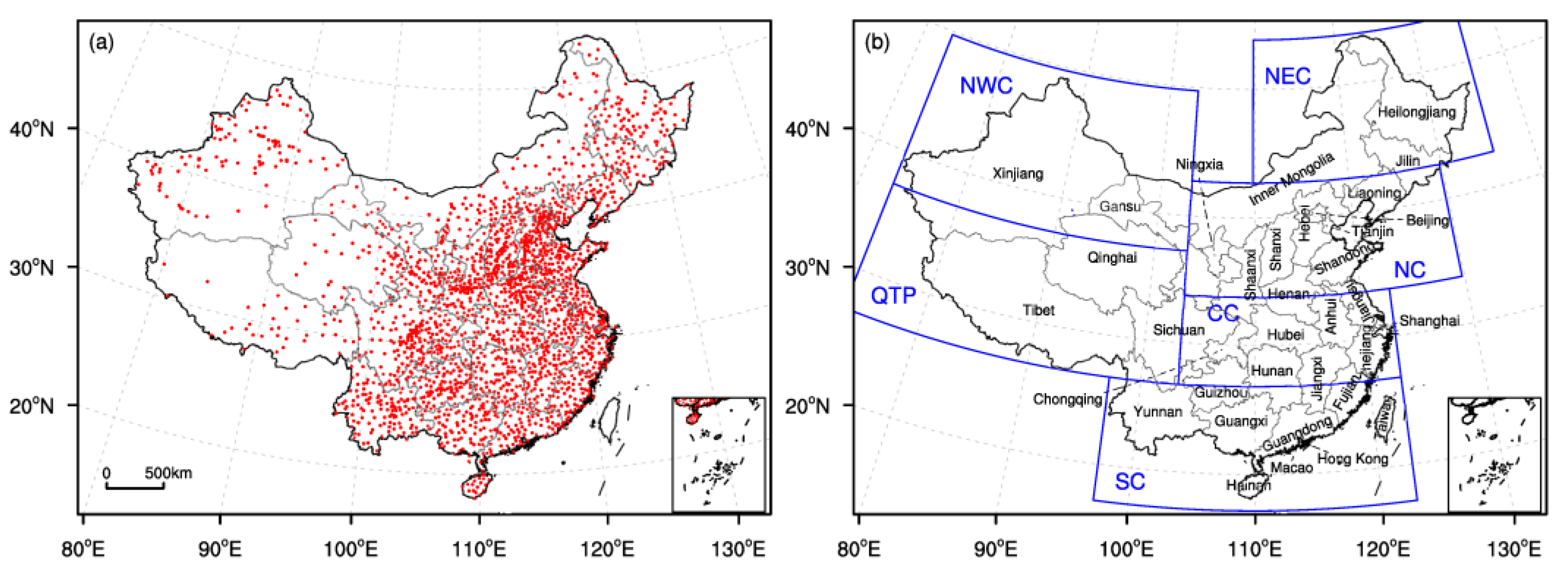
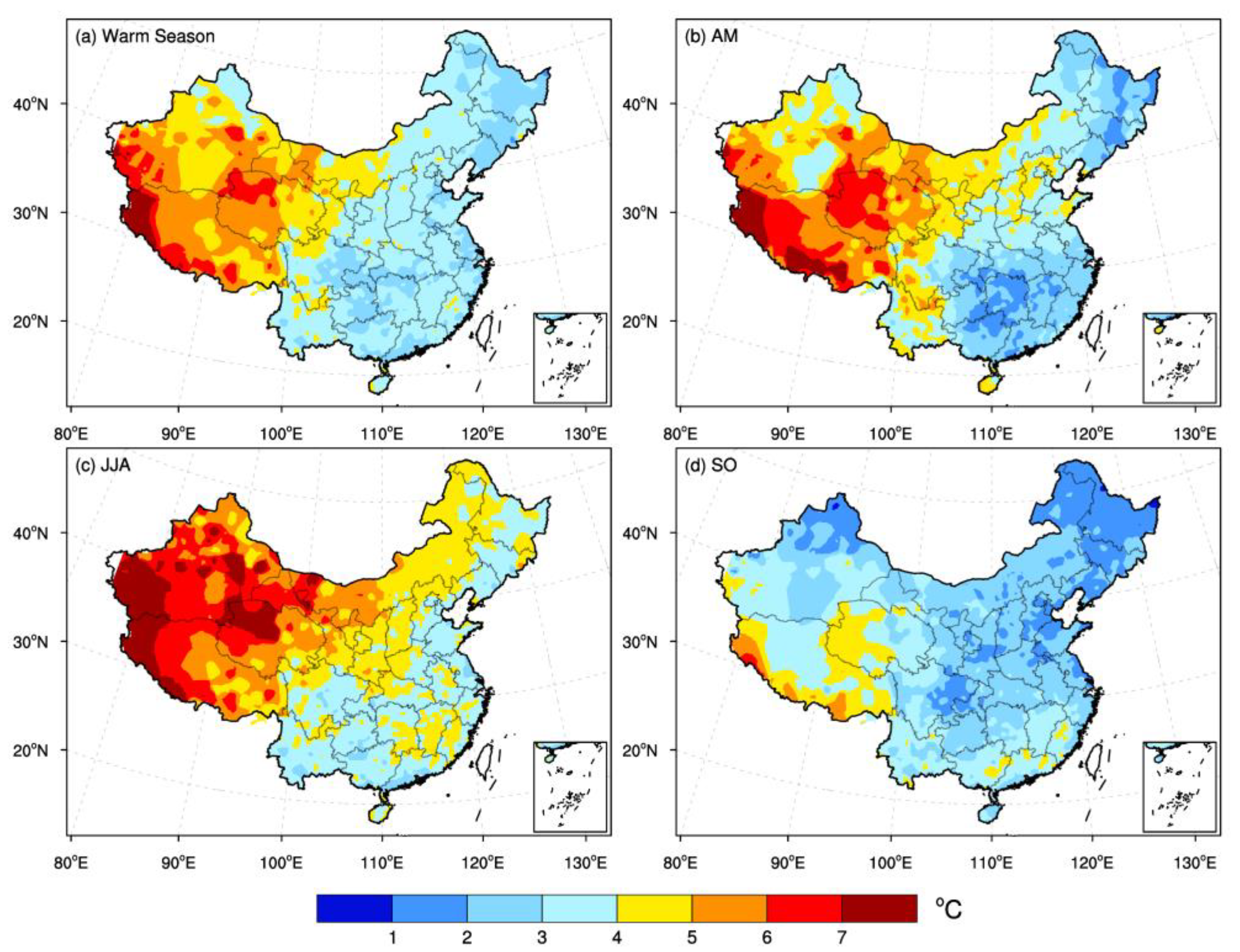

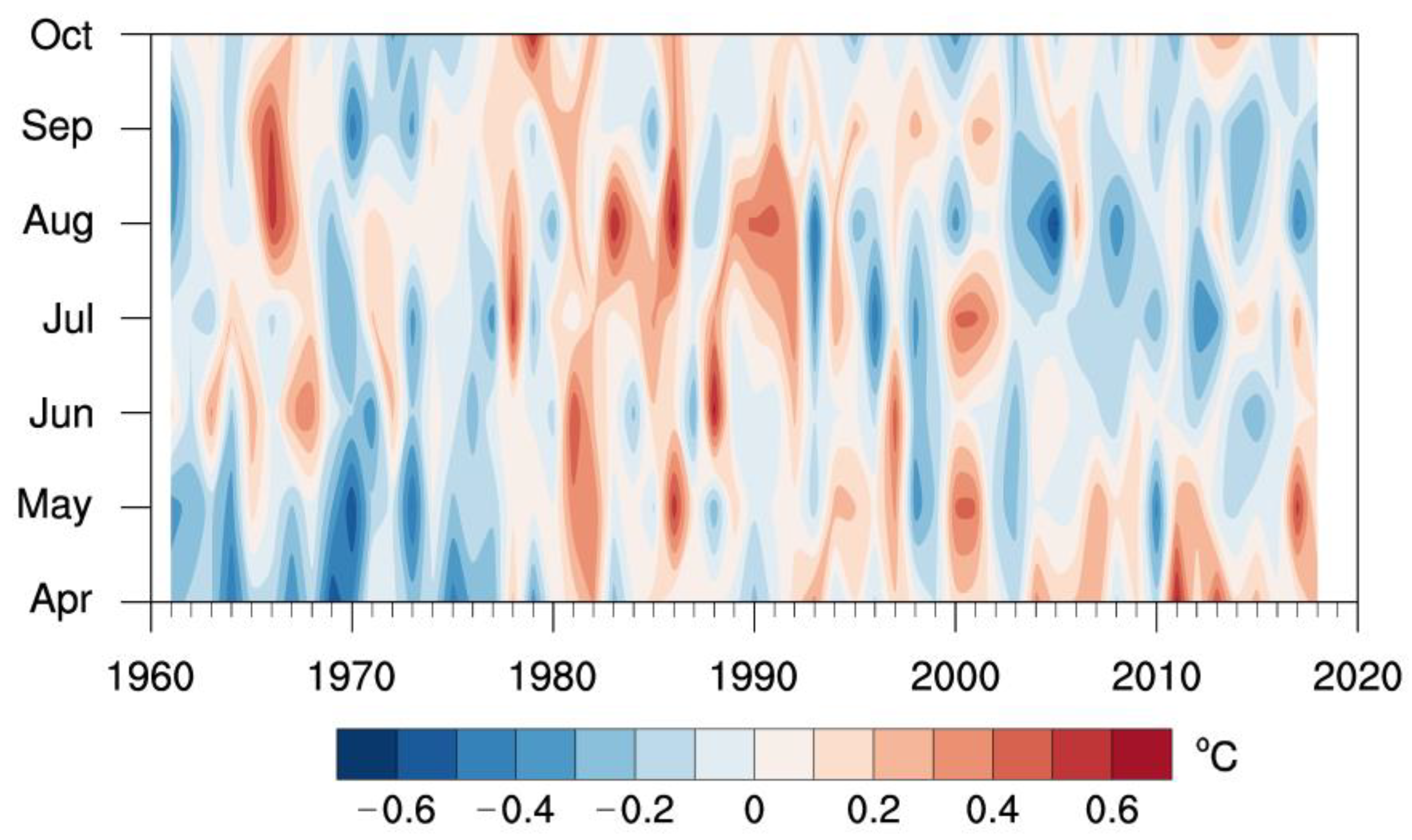
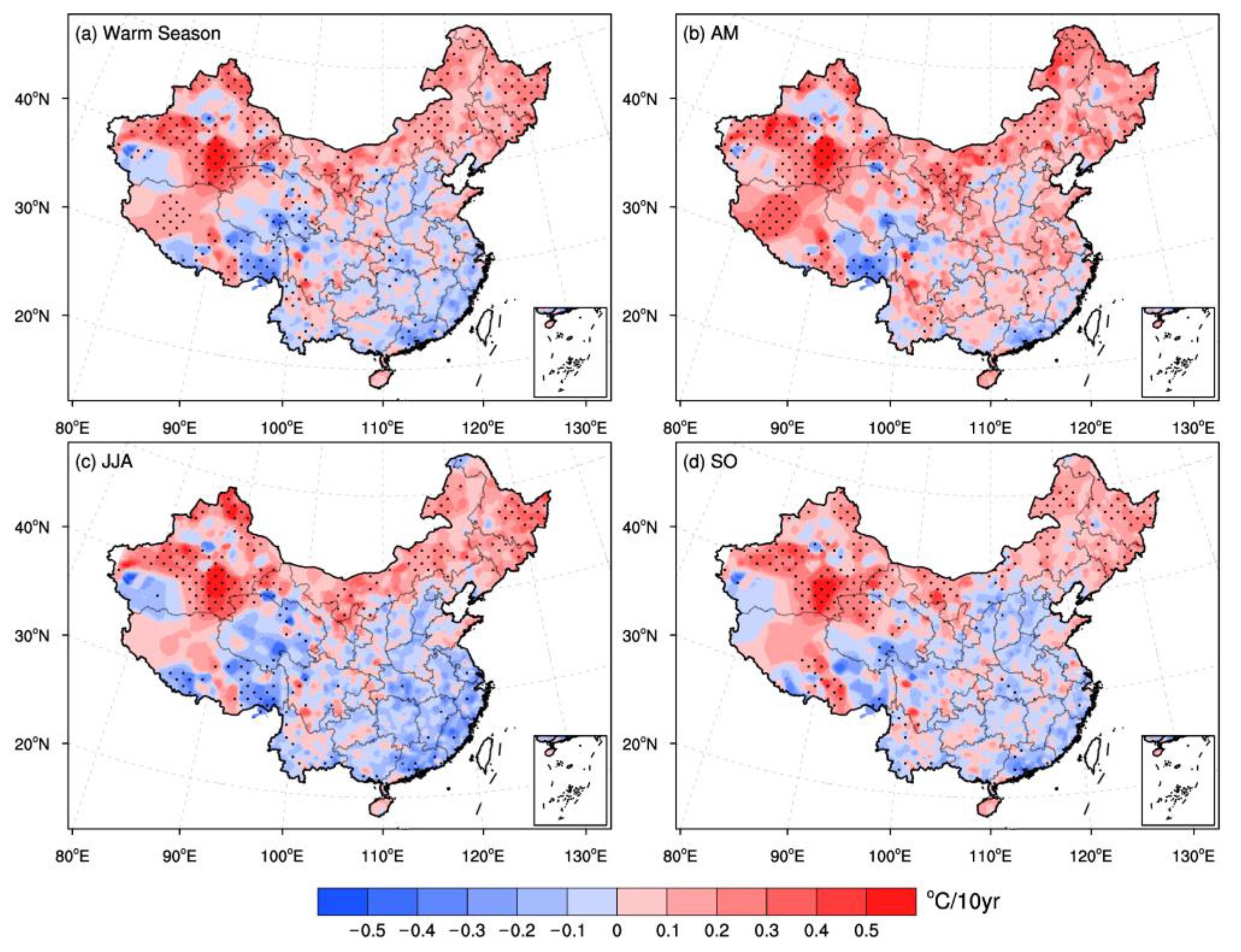

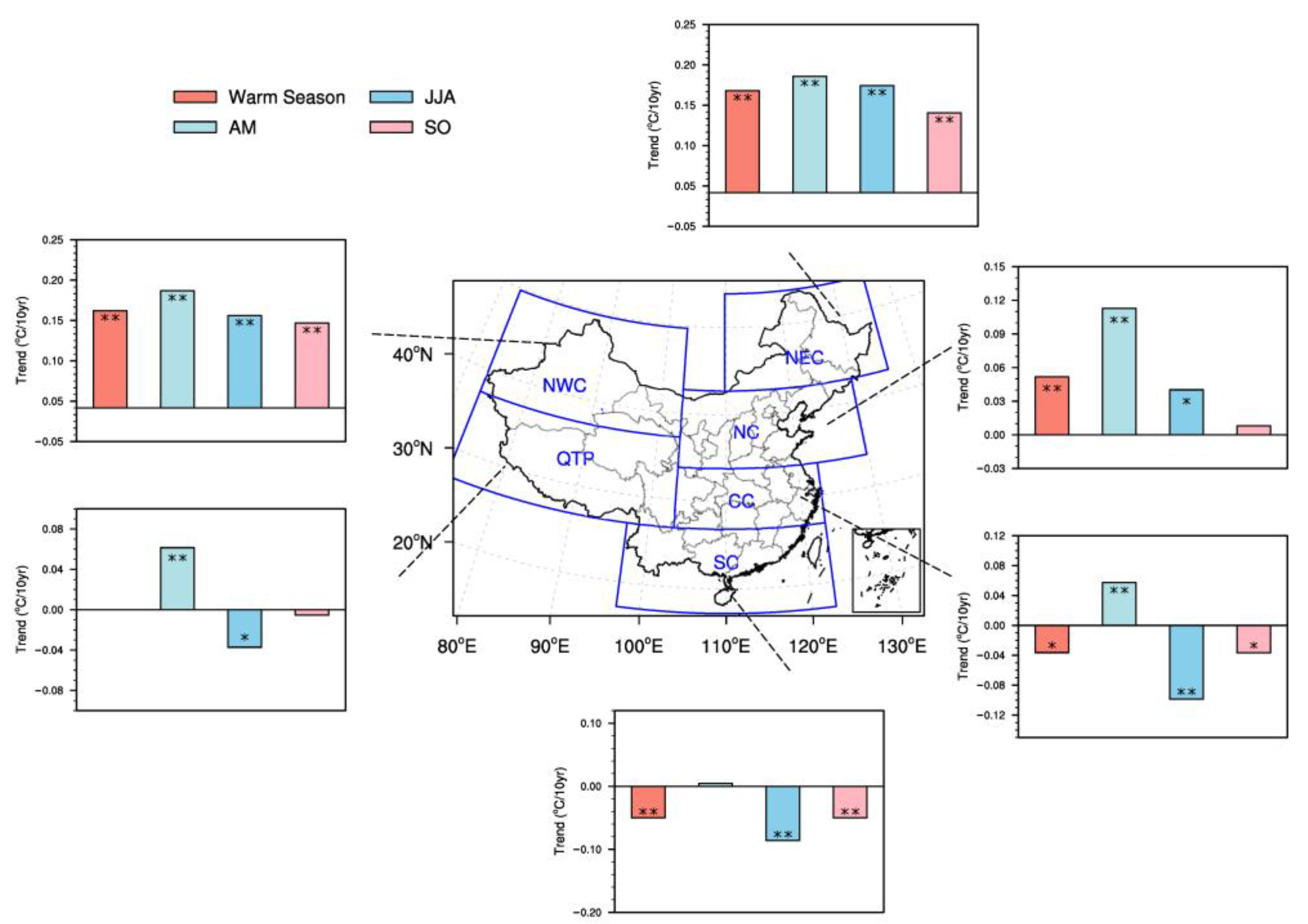

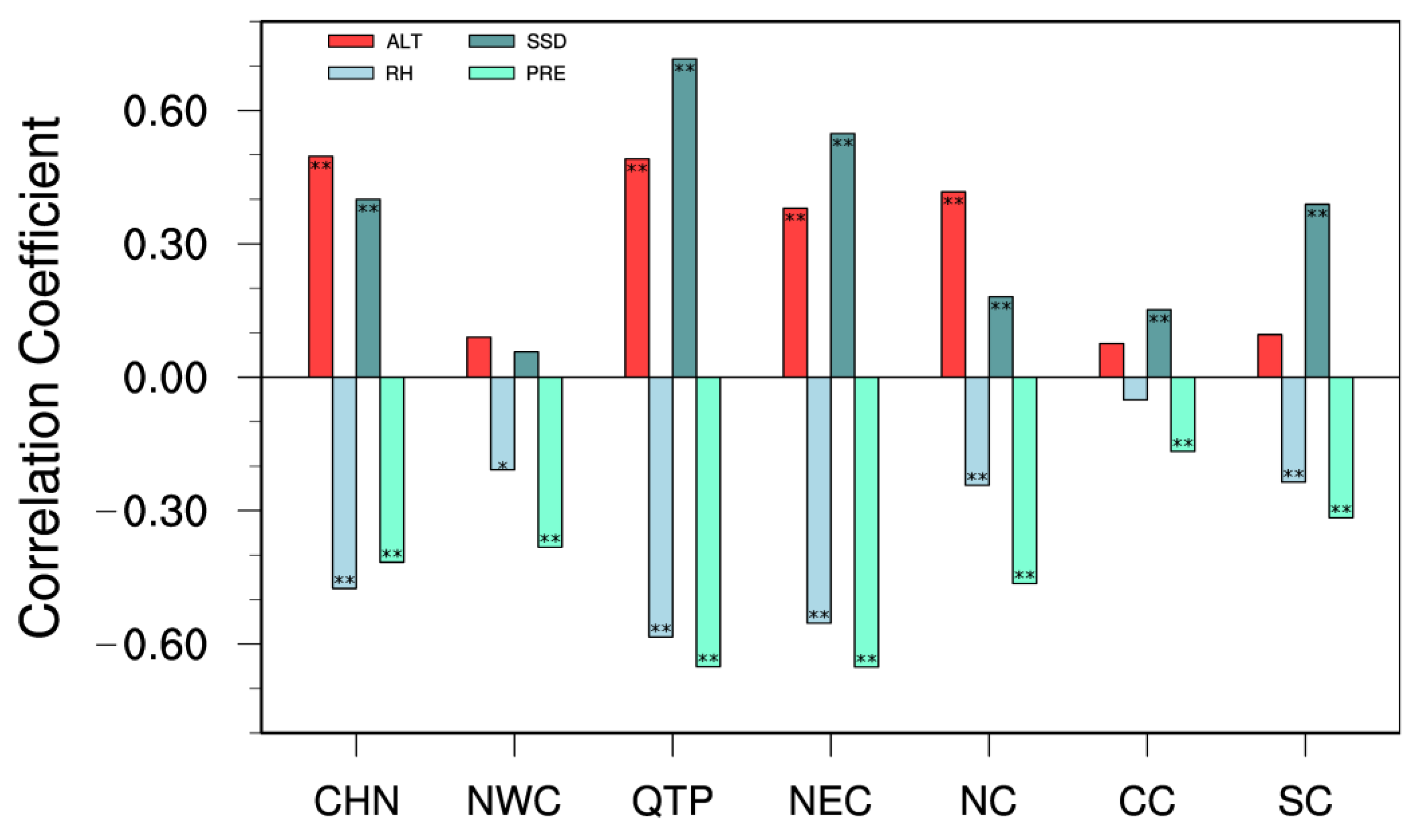
| SAT (°C) | Precipitation (mm) | RH (%) | Urbanization Level | |
|---|---|---|---|---|
| NWC | 16.03 | 119.88 | 43.05 | 2.71 |
| QTP | 10.74 | 436.42 | 56.44 | 1.86 |
| NEC | 13.90 | 422.00 | 61.55 | 3.18 |
| NC | 17.66 | 486.31 | 63.60 | 3.03 |
| CC | 22.13 | 960.19 | 76.15 | 3.14 |
| SC | 23.72 | 1255.02 | 77.84 | 3.07 |
| Trend (°C/10yr) | Mean (°C) | |||||
|---|---|---|---|---|---|---|
| GST | SAT | GST–SAT | GST | SAT | GST–SAT | |
| Warm Season | 0.27 ** | 0.23 ** | 0.04 ** | 21.44 | 17.43 | 3.88 |
| AM | 0.35 ** | 0.25 ** | 0.10 ** | 18.25 | 14.29 | 3.81 |
| JJA | 0.22 ** | 0.20 ** | 0.02 * | 26.48 | 21.68 | 4.67 |
| SO | 0.26 ** | 0.24 ** | 0.03 ** | 17.07 | 14.20 | 2.75 |
| GST–SAT’s Trend (°C/10yr) | Warm Season | AM | JJA | SO |
|---|---|---|---|---|
| HOMO (2171 stations) | 0.04 ** | 0.10 ** | 0.02 * | 0.02 ** |
| Non-HOMO (2171 stations) | 0.07 ** | 0.12 ** | 0.05 ** | 0.05 ** |
| HOMO (775 stations) | 0.03 ** | 0.09 ** | 0.01 | 0.02 * |
Disclaimer/Publisher’s Note: The statements, opinions and data contained in all publications are solely those of the individual author(s) and contributor(s) and not of MDPI and/or the editor(s). MDPI and/or the editor(s) disclaim responsibility for any injury to people or property resulting from any ideas, methods, instructions or products referred to in the content. |
© 2023 by the authors. Licensee MDPI, Basel, Switzerland. This article is an open access article distributed under the terms and conditions of the Creative Commons Attribution (CC BY) license (https://creativecommons.org/licenses/by/4.0/).
Share and Cite
Long, Y.; Ren, G. Spatio-Temporal Patterns of Warm-Season Ground Surface Temperature—Surface Air Temperature Difference over China Mainland. Land 2023, 12, 1057. https://doi.org/10.3390/land12051057
Long Y, Ren G. Spatio-Temporal Patterns of Warm-Season Ground Surface Temperature—Surface Air Temperature Difference over China Mainland. Land. 2023; 12(5):1057. https://doi.org/10.3390/land12051057
Chicago/Turabian StyleLong, Yiwen, and Guoyu Ren. 2023. "Spatio-Temporal Patterns of Warm-Season Ground Surface Temperature—Surface Air Temperature Difference over China Mainland" Land 12, no. 5: 1057. https://doi.org/10.3390/land12051057
APA StyleLong, Y., & Ren, G. (2023). Spatio-Temporal Patterns of Warm-Season Ground Surface Temperature—Surface Air Temperature Difference over China Mainland. Land, 12(5), 1057. https://doi.org/10.3390/land12051057






